Global patent statistical analysis for drug testing technology
Abstract
BACKGROUND:
In recent decades, illicit drug testing has become a high priority area in law enforcement and forensic analysis.
OBJECTIVE:
Since patents are the largest source of technical information in the world, patent database analysis for illicit drug testing is extremely important to effectively promote the development and protection of the related intellectual property rights.
METHODS:
In the present study, we first retrieve a database of 1732 drug detection patents using keywords and logical expressions related to the title, abstract, and claims, and subsequently discuss the current global patent statistics in detail.
RESULTS:
The relevant patent information is presented, including patent application quantity, filing country, ownership, and technical field.
CONCLUSIONS:
Finally, we summarize the current development trend in drug testing and propose several suggestions focused on the bottleneck of analytical techniques.
1.Introduction
Currently, drug abuse poses a serious threat to human health and social harmony and as such, drug testing has become a hot topic and point of difficulty in the field of analysis. According to the World Drug Report 2019 [1], an estimated 35 million individuals suffer from drug use disorders. Drug abuse has indirectly led to an increase in the number of individuals infected with HIV and hepatitis C virus. Further, the spread of drug use can seriously endanger social security, causing an increase in criminal cases and drug-impaired driving. Drug-impaired driving has surpassed alcohol-impaired driving to become the major cause of car accident-related death [2, 3, 4]. A lack of suitable on-site and roadside drug testing devices for rapid the screening of biological samples renders the combat of drug-impaired driving extremely difficult. Moreover, the inspection cycle of traditional laboratory testing technology is relatively long. New methods and equipment of variable quality cannot meet the needs of rapid on-the-spot detection due to the disadvantages of expensive apparatus and complicated manipulation. Besides, many companies opt for foreign products without after-sales service or low-end instruments to reduce cost. In view of this, it is imperative to promote the R&D and innovation of novel rapid testing technology.
In an era of knowledge economy, it is generally believed that patents, the largest source of technical information worldwide, are a crucial index for evaluating the ability of scientific and technological innovation in different regions [5]. Through patent analysis for drug testing technology, we can make effective use of patent information, in addition to developing and protecting independent intellectual property rights. The competition involved in drug testing is mainly reflected by patent applications. The present study aims to provide a comprehensive overview of patents concerning this subject, including patent application quantity, filing countries, ownership, and technical areas. New technologies should be patented prior to being published since patents are time sensitive. Because of the development of modern analytical technology, an increasing number of new instruments are applied to drug detection, providing better, faster, and simpler methods. Scholars worldwide have attempted drug testing techniques and academic reports are increasing; however, research on patents is scarce. In comparison with the United States, Europe, and other developed countries, China started relatively late in the aspect of patent information analysis [6]. Accordingly, we discuss a set of 1732 drug testing patents granted and filed before 2020 with a view to creating a comprehensive understanding of the patent information in this field, highlighting the latest trends, and improving the starting point of our own R&D.
2.Materials and methods
2.1Patent retrieval and data cleaning
In the present study, patents and patent applications were extracted from Patsnap [7], a rapidly developing innovative technology company that offers over 140 million patents from 116 countries worldwide. The patents were searched by combining different terms related to drug testing. Searches were carried out in the titles, abstracts, and claims of patent documents and refined by manual selection. We deleted patents irrelevant to the subject, finally selecting 1732 patents for analysis.
2.2Quantitative patent analysis
Quantitative analysis is typically the quantitative analysis and scientific disclosure of the patent number, patent application, technology, and legal status.
2.3Qualitative patent analysis
Qualitative analysis uses a method based on the technical content of patents, integrating relevant patent literature according to technical characteristics and elucidating technological innovation to gain access to technological breakthrough.
2.4Bibliometrics
Bibliometrics embodies the trend of quantitative contemporary disciplines and is indispensable for extracting information from patent documents [8]. Statistical analysis based on a time series and the number of patents is actually the application of bibliometrics.
2.5Data mining
Data mining generally refers to the process of using scientific methods in various fields to extract implicit, pre-unknown models with great application value in large, incomplete, noisy, fuzzy, and random data, with a view to helping decision-makers find potential correlation between data and identify neglected factors [9]. The contribution of data mining to patent analysis lies in the fact that it provides an effective way to cluster patent texts.
3.Results and discussion
3.1Quantitative patent analysis
3.1.1Patenting trends
Global patent analysis shows that drug testing technology research has long been developing. After 2000, the number of applications began to grow rapidly, and the overall explosion was large (Fig. 1). Because of the development of science and the soundness of the socialist legal system, the content and scope of poison and drug analysis are becoming increasingly extensive, the variety of drugs involved in cases has increased dramatically, and the requirements for investigation and inspection of drug-related cases are increasing. Only by adopting modern and advanced analytical methods and techniques can the effective analysis of poisons and drugs be satisfied. New theories and achievements in many disciplines are being introduced to promote development, such as molecular pharmacology and pharmacokinetics, chromatography, spectroscopy, mass spectrometry, electrochemistry, immunology, and enzyme chemistry. With respect to the severe situation regarding the rapid spread of synthetic drugs, nations around the world are constantly strengthening the development of new technologies to improve accuracy and identification ability. Overall, the development of drug analysis technology has good prospects.
Figure 1.
Analysis of global patent application trends.
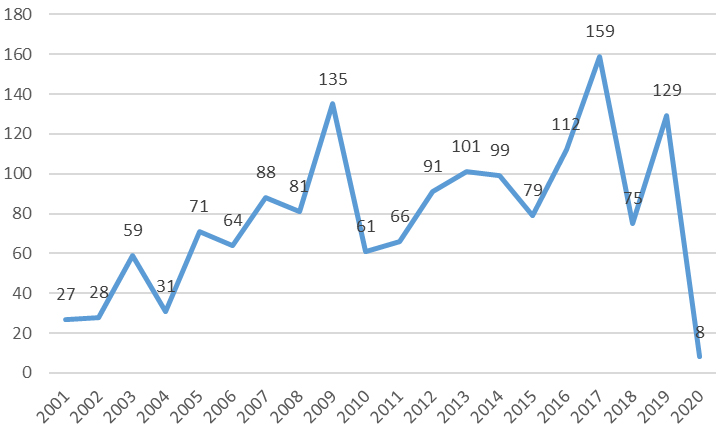
3.1.2Analysis of major applicants
Statistics indicate that NUCTECH Co. Ltd. is the largest applicant, followed by Roche and Tsinghua University. NUCTECH, a spin-off company of Tsinghua University founded in 1997, is one of the most advanced security and inspection solution and service supplier in the world. Relying on independent innovation, NUCTECH provides the most advanced technology, superb products, and integrated solutions to the security inspection industry. Tsinghua University, as a well-known Chinese academic institution, generates research results in the field of drug testing, which are transformed into marketed products in cooperation with NUCTECH. Roche is a multinational enterprise based on scientific research and development, with large research centers worldwide. The remaining applicants are Battelle Energy Alliance, IFSC (Institute of Forensic Science of China), Cozart Bioscience, Shanghai Research Institute of Criminal Science and Technology, Medical Diagnostics, TEKNOLOGIAN TUTKISKUS VTT, and Intel Corporation, all of which have relatively low applications. (Fig. 2)
Figure 2.
Analysis of major applicants.
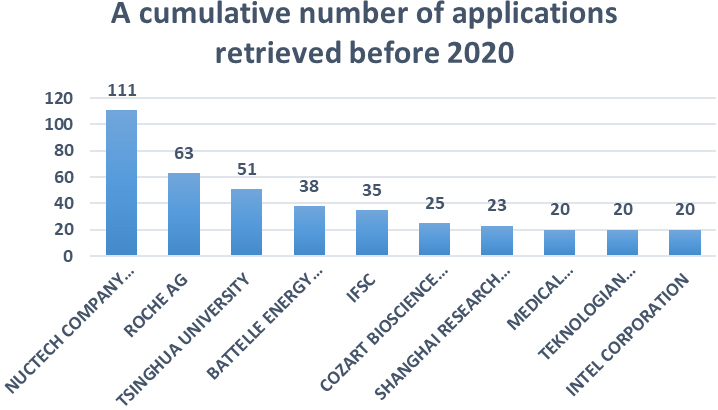
Figure 3.
Application analysis of IFSC and Shanghai Research Institute of Criminal Science and Technology.
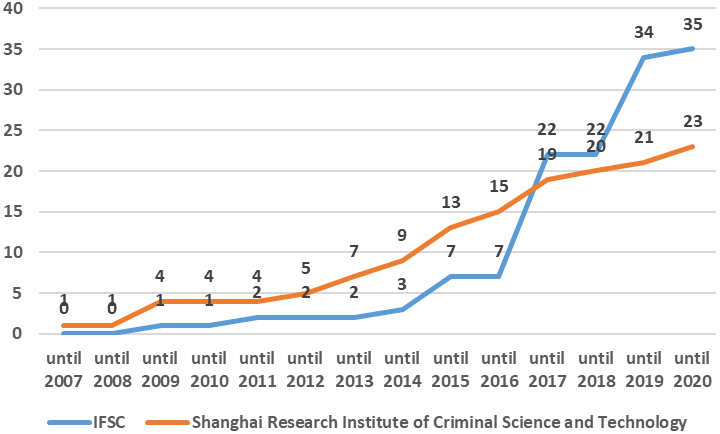
In recent years, the number of applications from IFSC and Shanghai Research Institute of Criminal Science and Technology has continued to increase, indicating that drug testing is currently an important part of criminal science and technology work. The data represent the cumulative number over the period of a fiscal year (Fig. 3). Although the number of applications varies in a particular year, the cumulative number is obviously increasing. In drug crime cases, a large amount of heroin, opium, marijuana, and other drugs are involved, and almost every case is inseparable from every scientific appraisal conducted by criminal laboratory personnel [10]. Concerning actual public security, an effective fight against drug crimes depends on the progress of science and technology; therefore, increasing attention is being paid to drug detection technology and the parameters are constantly improving.
Intuitively, although the total number of private enterprises is twice that of universities and scientific research institutes, the number of patent applications is relatively concentrated in the latter two (Fig. 4). Most of the top rankings are companies that cooperate with universities to combine production, education, and research; however, private companies have many small and medium-sized enterprises, and the distribution of patents is scattered. From the above analysis, it can be seen that the current research on this technology in China is mostly concentrated in universities and scientific research institutions, with a relatively small proportion of enterprises. In view of the current situation, domestic companies can conduct specialized research on foreign technology, absorb its essence, and subsequently solve the technical bottlenecks encountered.
Table 1
Definitions of IPC [11]
| Subclass | Definition | Group |
|---|---|---|
| G01N | Testing or analyzing materials by measuring their chemical or physical properties | G01N33 |
| G01N30 | ||
| G01N21 | ||
| G01N23 | ||
| G01N27 | ||
| G01N01 | ||
| G01N31 | ||
| A61K | Products for medical, dental, or dressings | A61K31 |
| A61K39 | ||
| C07K | Peptides | C07K14 |
| C07K16 | ||
| G01V | Geophysical; gravity measurement; detection of substances or objects; tracer | G01V5 |
| C12Q | Including enzymes or microbial assays | C12Q1 |
| C12N | Microbial assays or enzymes; composition | C12N15 |
| G01J | Measurement of the intensity, velocity, spectral composition, polarization, phase, or pulse characteristics of infrared, visible, and ultraviolet light; colorimetry; radiometric pyrometry (2) | G01J3 G01J1 |
| B01L | General chemical or physical laboratory equipment | B01L3 |
Figure 4.
Distribution of patents in universities and the private sector.

3.1.3IPC technical composition analysis
The technical composition analysis of IPC (International Patent Classification) shows that the main innovations in global drug testing are concentrated in G01N, A61K, C07K, G01V, C12Q, C12N, G01J, and B01L (Fig. 5). We report definitions [11] of IPC in Table 1. Among them, G01N accounts for the largest number of global patent applications (1158 patents), indicating that the global technologies for “testing or analyzing materials by measuring their chemical or physical properties” are relatively mature. Major patents are concentrated in G01N33, G01N30, and G01N21. The technical fields, such as A61K, C07K, G01V, C07D, C12Q, C12N, G01J, and B01L have a certain amount of patent applications but do not differ significantly, indicating that there is certain R&D strength in these fields but they are not yet mature. Patents are the world’s largest source of technological information. When evaluating the technological innovation capabilities of different regions, patents are not the only indicator, but are crucial indicators. Here, by comparing different technical fields, it can be seen that the application of technologies in fields with a small number of patent applications is not yet mature in drug detection.
Figure 5.
IPC technical composition analysis.
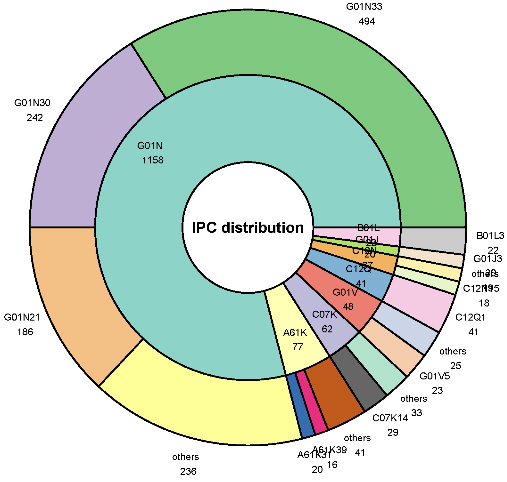
3.1.4Analysis of annual applications for IPC
By performing the annual analysis of IPC, the concentrated areas of technological development over recent years and how they have advanced can be understood (Fig. 6). The X-axis of the chart indicates the year in which the patent was filed between 2000 and 2020. The rapid development of technologies in G01N33, G01N30, and G01N21 shows that these technologies are the key directions for competitors in the field of drug testing. Among them, G01N33 is R&D for drug testing technology, in which more patents are applied for every year. The amount of applications in G01N30 and G01N21 is increasing year by year, indicating that chromatography and infrared/ultraviolet spectroscopy are also key areas with good prospects. Meanwhile, the continuity of annual applications in technologies related to G01N23, G01N27, C12Q1, G01N1, G01N31, C07K14, C07K16, G01V5, B01L3, A61K31, G01J3, C12N15, and A61K39 is poor. There have been no applications for several consecutive years involving electrochemical radiation, spectrometry, microbiological assays, or pharmaceutical preparations, suggesting that the current technical level in these areas is relatively lower; however, there are certain development prospects that will become possible technical breakthroughs.
Figure 6.
Analysis of annual applications for IPC.
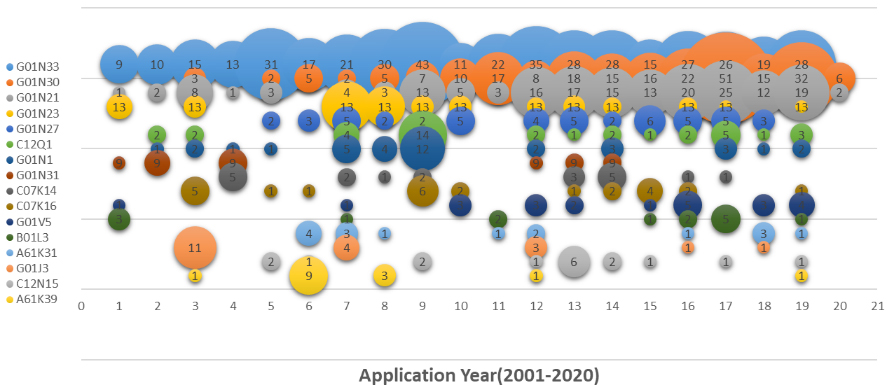
Figure 7.
Patent layout analysis.
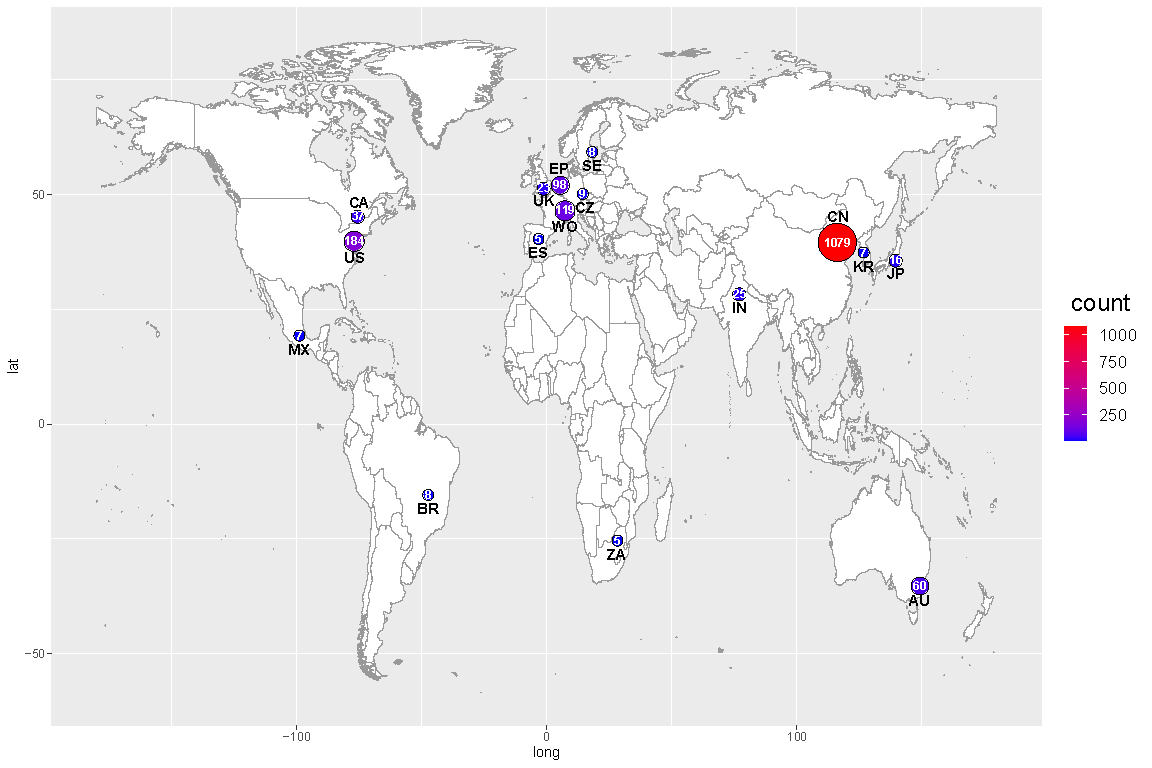
3.1.5Patent layout analysis
Results for global patents related to drug testing show that China has the largest number of patent applications (1079), accounting for 62.3% of total applications worldwide, which is followed by United States, World Intellectual Property Organization, and European patents (Fig. 7). Total applications in the top nine countries account for 94.75%, indicating that technologies in these countries are more mature. China has maintained pace with the rest of the world in research and application of drug testing technology. NUCTECH and Tsinghua University are the two representative units for a combination of industry, science, and research. In the early days, the main domestic achievements were focused on extraction and analytical technology, analysis methods for new medicines, and research into new products. Based on actual domestic cases, these studies utilized foreign advanced technologies to solve many practical problems in poisoning cases. Most of these methods are advanced in China and a few are advanced in other parts of the world [12]. In the United States, analysis of saliva samples is widely performed in special workplaces, medical management, and drug-impaired driving [13, 14]. Among the European countries, Great Britain, Russia, and Germany are the leading representatives of R&D related to drug testing technology. In Asia, Japan and South Korea have also achieved certain success in this field, playing a role all over the world. In summary, China, the United States, Europe, and Japan are the major countries and districts for patent applications, illustrating great technical innovation input for drug testing and mastering of core technologies in this field.
3.2Qualitative patent analysis
3.2.1Analysis from the perspective of patent type
Patents are an important index for technological innovation output. According to different technological content, patents can be divided into invention patents, appearance design patents, and utility model patents [15]. Data show that invention patents dominate among all global patents in the field of drug testing, accounting for 93% (Fig. 8). Among them, 1131 are patents for invention and 472 are authorized inventions. The number of utility model patents is 96, accounting for 5% (Fig. 8). The number of appearance design patents is 33, accounting for 2% (Fig. 8). Invention patents specified in patent law include product invention and technique innovation, such as equipment and manufacturing methods. Invention patents are applied to a wider field as compared with utility model patents. Technologies included in invention patents can be either radical inventions with revolutionary changes in a certain discipline or incremental inventions based on existing technology. Due to the late start and low level of drug testing in China, knowledge and technology update rapidly. Under the scientific and technological development trend, applying for invention patents is more beneficial to the autonomy of intellectual property rights for domestic enterprises or scientific research institutes, which will produce the greatest value.
Figure 8.
Distribution of the three patent types.

3.2.2Validity analysis of patent applications
With respect to grasping the legal status of patents, examining the current status and putting forward corresponding suggestions can provide a reference for the rational formulation of future scientific research strategies. There are 706 authorized patents, accounting for 40.76% of the total number of patents, to which special attention should be paid (Fig. 9). Due to legal protection, researchers should circumvent the corresponding technologies to avoid infringement. Patents under review include issued patents and substantive examination patents. The number of substantive examination patents is 222, which accounts for 12.82%, indicating that applicants have paid great attention to patent applications recently, with a view to maximizing the value of the technology (Fig. 9). The number of invalid patents is 573, which includes 269 rejected or withdrawn patents and 197 patents related to unpaid annual fees (Fig. 9). The high proportion of rejected or withdrawn patents included in the invalid patents indicates that there exists low technological innovation ability. It should also be noted that the proportion of patents related to unpaid annual fees is relatively high, indicating that the awareness of patent protection law needs to be improved. In addition, there are 188 patents for which the validity is unknown.
Figure 9.
Global patent validity analysis.
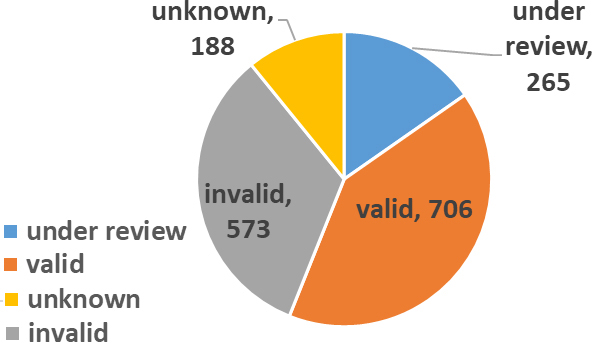
4.Conclusions
The drug problem facing the international community is very serious. By searching and analyzing patents related to global drug testing technologies, we can grasp the overall situation and the latest development trend in this field, providing an important basis for solving the corresponding practical problems. According to global patent analysis, the applications for drug testing patents are generally in the developmental stage of success. Technology for drug testing is mainly distributed in China, the United States, Europe, Australia, and Japan. In comparison with foreign countries where such technology is widely used, only small technical branches have made achievements in China. This field of technology has its own market in several foreign countries, while many domestic enterprises are foreign-funded. There are relatively few applicants with independent market in China, and many gaps exist for domestic enterprises; hence, there are many opportunities for technological development. Due to the continuous development of science and technology, the intensity of domestic investment research has also increased. China has researched a series of technical achievements according to the characteristics of domestic drug criminal cases in combination with foreign advanced technology, of which many have reached a relatively advanced level worldwide. In response to the call of “strengthening police by science and technology” led by the central government and the Ministry of Public Security, major public inspection and law systems in China actively innovate and develop technology for drug testing, with a timely update of the equipment needed for experiments. In certain difficult cases, GC, GC/MS, and HPLC have been used in concert for drug analysis. We suggest that the future development of this technology in China will also show a thriving trend.
In general, many factors affect the development of drug testing in China, such as poor work, the difference in technical level among institutes, and insufficient attention from the leadership. leading to the inability to carry out normal case and inspection work. In view of the current situation, it is necessary to find the right direction, strengthen cooperation, and concentrate on technological breakthroughs. Secondly, we should realize the combination of industry, research, and development, improve the innovation ability of enterprises, and formulate intellectual property development strategy and the research and development route. We should focus on key technologies for evasive design, avoid patent traps, actively layout independent technology, form a complete patent portfolio, protect intellectual property, and finally take a feasible path to research and development.
Acknowledgments
This work was financially supported by the Program for National Natural Science Foundation of China (Nos 81871523, 81671458 and 81971440), the Young Innovative Research Team in China University of Political Science and Law (18CXTD09), the Academician Foundation of the Ministry of Public Security of the People’s Republic of China (2011-23317015), the Research innovation Program of China University of Political Science and Law (1000/10818412), and the Cooperation Project (2017YC0820802-1, 2017YFC0820802-5).
Conflict of interest
None to report.
References
[1] | UN issues “World Drug Report 2019” [homepage on the Internet]. Available from: http://worldpeople.com.cn/n1/2019/0627/c1002-31199347.html. |
[2] | McIntosh J, O’Brien T, McKeganey N. Drug driving and the management of risk: the perspectives and practices of a sample of problem drug users. Int J Drug Policy. (2008) ; 19: (3): 248-254. doi: 10.1016/j.drugpo.2006.12.003. |
[3] | Darke S, Kelly E, Ross J. Drug driving among injecting drug users in Sydney, Australia: prevalence, risk factors and risk perceptions Addiction. (2004) ; 99: (2): 175-185. doi: 10.1046/j.1360-0443.2003.00604.x. |
[4] | Kelly E, Darke S, Ross J. A review of drug use and driving: epidemiology, impairment, risk factors and risk perceptions. Drug Alcohol Rev. (2004) ; 23: (3): 319-344. doi: 10.1080/09595230412331289482.. |
[5] | Wanlin Z. Research on Evaluation of regional science and technology innovation capability based on the analysis of patent information. Jiangsu: Jiangsu University, (2017) . |
[6] | Guilin Z. Research on patent analysis method and search in the field of coffee application in China. Hubei: Huazhong University of Science and Technology, (2014) . |
[7] | Patsnap [homepage on the Internet]. Available from: http://wwwzhihuiya.com/. |
[8] | Yi L, Daisu L. A review of S&T information-oriented patent analysis and applications. Science and Technology Management Research, (2018) ; 38: (22): 162-167. |
[9] | Fan Y. Design and realization of library management system based on data mining technology. Sichuan: University of Electronic Science and Technology, (2014) . |
[10] | Weimin Y. Further give play to the important role of criminal testing in combating drug crimes. Proceedings of the First National Drug Testing Technology Exchange Conference, (1997) . |
[11] | The eight sub-volumes of the Chinese version of the IPC classification table (A-G) [homepage on the Internet]. |
[12] | Bo Y, Cuiying M, Bo Z. Current status and development trend of poison and drug inspection at home and abroad. Journal of People’s Public Security University of China (Science and Technology). (2004) ; (2): 48-51. |
[13] | Zhongshan Y, Jun Z, Yao L. The application of saliva in drug detection. Chinese Journal of Forensic Medicine. (2013) ; 28: (1): 26-29. |
[14] | Drummer OH. Review: Pharmacokinetics of illicit drugs in oral fluid. Forensic Sci Int. (2005) ; 150: (2-3): 133-142. doi: 10.1016/j.forsciint.2004.11.022. |
[15] | Jiayi L. Research on the effect of credit on industrial structure upgrading from the perspective of patent type. Beijing Jiaotong University. (2019) . |




